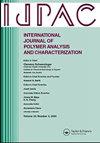Graft copolymerization of carboxymethylcellulose with solketal acrylate
IF 1.7
4区 工程技术
Q4 POLYMER SCIENCE
International Journal of Polymer Analysis and Characterization
Pub Date : 2025-01-02
DOI:10.1080/1023666X.2024.2445671
引用次数: 0
Abstract
The objective of this work is to synthesize new materials based on cellulose fiber. In this study, we presented the synthesis of a new biomaterial by conducting graft polymerization of 2,2-dimethyl-1,3-dioxolan-4-yl methyl acrylate (DMDMA solketal acrylate) onto carboxymethylcellulose (CMC), using KPS as an initiator. We conducted several experiments to determine the optimal conditions for preparing this biopolymer, varying the reaction time and the ratio between the initiator and the monomer. The results revealed that the highest grafting yield, 52%, was obtained after 72 min at 65 °C, with 6.26 mmol of KPS/eq OH and 4.43 moles of DMDMA/eq OH, using THF as a solvent. FTIR spectroscopy confirmed the grafting of monomers onto the CMC. Thermogravimetry showed that the degradation of the grafted CMC occurs in two stages, unlike the degradation of the CMC, which occurs in a single stage, confirming the modification of the starting product. SEM images clearly show the morphological difference between the CMC and the grafted CMC. The BET analysis reveals moderate adsorption at low pressure, followed by a marked increase at high pressure, indicating the presence of mesopores. The hysteresis between adsorption and desorption also suggests closed pore structures. The pore size distribution shows a predominance of pores between 30 and 100 Å, providing an optimal specific surface area for small molecule adsorption and catalytic reactions. This mesoporous profile is suitable for adsorption and catalysis applications. To our knowledge, our study represents the first use of the synthesized monomer, DMDMA solketal acrylate, for grafting onto the structure of CMC, highlighting the originality of our research.
羧甲基纤维素与丙烯酸酯溶胶的接枝共聚
本工作的目的是合成基于纤维素纤维的新材料。在本研究中,我们以KPS为引发剂,在羧甲基纤维素(CMC)上接枝聚合2,2-二甲基-1,3-二氧唑兰-4-酰基丙烯酸甲酯(DMDMA - solketal acrylate),合成了一种新的生物材料。我们进行了几个实验来确定制备这种生物聚合物的最佳条件,改变了反应时间和引发剂和单体之间的比例。结果表明,以THF为溶剂,在65℃条件下,以6.26 mmol KPS/eq OH和4.43 mol DMDMA/eq OH为溶剂,反应72 min,接枝率最高,为52%。FTIR光谱证实了单体接枝到CMC上。热重测定结果表明,接枝CMC的降解分两个阶段进行,而CMC的降解只发生一个阶段,证实了起始产物的改性。SEM图像清晰地显示了CMC与接枝CMC的形态差异。BET分析显示,在低压下,吸附量适中,在高压下,吸附量明显增加,表明介孔的存在。吸附和解吸之间的滞后也表明孔隙结构是封闭的。孔径分布在30 ~ 100 Å之间,为小分子吸附和催化反应提供了最佳的比表面积。这种介孔结构适合于吸附和催化应用。据我们所知,我们的研究是第一次将合成的单体DMDMA溶胶丙烯酸酯接枝到CMC的结构上,突出了我们研究的独创性。
本文章由计算机程序翻译,如有差异,请以英文原文为准。
求助全文
约1分钟内获得全文
求助全文
来源期刊
CiteScore
3.50
自引率
5.30%
发文量
37
审稿时长
1.6 months
期刊介绍:
The scope of the journal is to publish original contributions and reviews on studies, methodologies, instrumentation, and applications involving the analysis and characterization of polymers and polymeric-based materials, including synthetic polymers, blends, composites, fibers, coatings, supramolecular structures, polysaccharides, and biopolymers. The Journal will accept papers and review articles on the following topics and research areas involving fundamental and applied studies of polymer analysis and characterization:
Characterization and analysis of new and existing polymers and polymeric-based materials.
Design and evaluation of analytical instrumentation and physical testing equipment.
Determination of molecular weight, size, conformation, branching, cross-linking, chemical structure, and sequence distribution.
Using separation, spectroscopic, and scattering techniques.
Surface characterization of polymeric materials.
Measurement of solution and bulk properties and behavior of polymers.
Studies involving structure-property-processing relationships, and polymer aging.
Analysis of oligomeric materials.
Analysis of polymer additives and decomposition products.

 求助内容:
求助内容: 应助结果提醒方式:
应助结果提醒方式:


